Investigation of the Properties of Anti-Friction Coatings Deposited with Different Casting Methods
Abstract
1. Introduction
2. Materials and Experimental Details
3. Results and Discussion
3.1. Chemical Composition
3.2. Tensile Test
3.3. Hardness Test
3.4. Microstructure
4. Conclusions
Author Contributions
Funding
Institutional Review Board Statement
Informed Consent Statement
Data Availability Statement
Acknowledgments
Conflicts of Interest
References
- Leszczynska-Madej, B.; Hrabia-Wisnios, J.; Węglowska, A.; Perek-Nowak, M.; Madej, M. Experimental investigations of heat generation and microstructure evolution during friction stir processing of SnSbCu alloy. Arch. Civ. Mech. Eng. 2022, 22, 202. [Google Scholar] [CrossRef]
- Zhang, X.; Wu, S.; Liu, W.; Chu, X.; Xie, Y.; Zhang, F. High performance tin-based Babbitt coatings deposited by high-pressure cold spraying. Surf. Coat. Technol. 2023, 473, 130048. [Google Scholar] [CrossRef]
- Zhang, Y.; Tudela, I.; Pal, M.; Kerr, I. High strength tin-based overlay for medium and high speed diesel engine bearing tribological applications. Tribol. Int. 2016, 93, 687–695. [Google Scholar] [CrossRef]
- Zhang, D.; Ho, J.K.L.; Dong, G.; Zhang, H.; Hua, M. Tribological properties of Tin-based Babbitt bearing alloy with polyurethane coating under dry and starved lubrication conditions. Tribol. Int. 2015, 90, 22–31. [Google Scholar] [CrossRef]
- Wang, W.; Yuan, W.; Guo, Q.; Wang, N.; Chi, B.; Yu, J. Effect of picosecond laser surface texturing under Babbitt coating mask on friction and wear properties of GCr15 bearing steel surface. Eng. Fail. Anal. 2024, 157, 107878. [Google Scholar] [CrossRef]
- Dong, Q.; Yin, Z.; Li, H.; Zhang, X.; Jiang, D.; Zhong, N. Effects of Ag micro-addition on structure and mechanical properties of Sn-11Sb-6Cu Babbitt. Mater. Sci. Eng. A-Struct. 2018, 772, 225–230. [Google Scholar] [CrossRef]
- Leszczynska-Madej, B.; Madej, M.; Hrabia-Wisnios, J.; Węglowska, A. Effects of the processing parameters of friction stir processing on the microstructure, hardness and tribology properties of SnSbCu bearing alloy. Materials 2020, 13, 5826. [Google Scholar] [CrossRef] [PubMed]
- Zhang, H.; Zhang, D.Y.; Hua, M.; Dong, G.N.; Chin, K.S. A study on the tribological behavior of surface texturing on Babbitt alloy under mixed or starved lubrication. Tribol. Lett. 2014, 56, 305–315. [Google Scholar] [CrossRef]
- Gebretsadik, D.W.; Hardell, J.; Prakash, B. Tribological performance of tin-based overlay plated engine bearing materials. Tribol. Int. 2015, 92, 281–289. [Google Scholar] [CrossRef]
- Leszczynska-Madej, B.; Madej, M. The properties of Babbitt bushes in steam turbine sliding bearings. Arch. Metall. Mater. 2011, 56, 805–812. [Google Scholar] [CrossRef]
- Tillmann, W.; Hagen, L.; Kensy, M.D.; Abdulgader, M.; Paulus, M. Microstructural and tribological characteristics of Sn-Sb-Cu-based composite coatings deposited by cold spraying. J. Therm. Spray Technol. 2020, 29, 1027–1039. [Google Scholar] [CrossRef]
- Naeimian, H.; Mofid, M.A. TLP bonding of Ti-6Al-4V to Al 2024 using thermal spray Babbitt alloy interlayer. Trans. Nonferrous Met. Soc. China 2020, 30, 1267–1276. [Google Scholar] [CrossRef]
- Koutsky, J.; Vesela, J. Evaluation of white metal adhesion (conventional casting and thermal wire arc spraying) by ultrasonic non-destructive method. J. Mater. Process. Technol. 2004, 157–158, 724–728. [Google Scholar] [CrossRef]
- Tillmann, W.; Hagen, L.; Abdulgader, M.; Kensy, M.D.; Paulus, M. Microstructural characteristics in babbitt coatings deposited by LPCS. Coatings 2020, 10, 689. [Google Scholar] [CrossRef]
- Junior, P.R.C.A.; Pukasiewicz, A.G.M. Evaluation of microstructure, mechanical and tribological properties of a Babbitt alloy deposited by arc and flame spray processes. Tribol. Int. 2019, 131, 148–157. [Google Scholar] [CrossRef]
- Schmidt, T.; Gartner, F.; Assadi, H.; Kreye, H. Development of a generalized parameter window for cold spray deposition. Acta Mater. 2006, 54, 729–742. [Google Scholar] [CrossRef]
- Xu, T.Z.; Zhang, S.; Wang, Z.Y.; Zhang, C.H.; Zhang, D.X.; Wang, M.; Wu, C.L. Wear behavior of graphite self-lubricating Babbitt alloy composite coating on 20 steel prepared by laser cladding. Eng. Fail. Anal. 2022, 141, 106698. [Google Scholar] [CrossRef]
- Xue, M.; Chandra, S.; Mostaghimi, J.; Salimijazi, H.R. Formation of pores in thermal spray coatings due to incomplete filling of crevices in patterned surfaces. Plasma Chem. Plasma Process. 2007, 27, 647–657. [Google Scholar] [CrossRef]
- Odhiambo, J.G.; Li, W.G.; Zhao, Y.T.; Li, C.L. Porosity and its significance in plasma-sprayed coatings. Coatings 2019, 9, 460. [Google Scholar] [CrossRef]
- Sobolev, V.V.; Guilemany, J.M. Oxidation of coatings in thermal spraying. Mater. Lett. 1998, 37, 231–235. [Google Scholar] [CrossRef]
- Nascimento, A.R.C.; Ettouil, F.B.; Moreau, C.; Savoie, S.; Schulz, R. Production of babbitt coatings by high velocity oxygen fuel (HVOF) spraying. J. Therm. Spray Technol. 2017, 26, 1732–1740. [Google Scholar] [CrossRef]
- Ni, Y.; Dong, G.; Tong, Z.; Li, X.; Wang, W. Effect of laser remelting on tribological properties of Babbitt alloy. Mater. Res. Express 2019, 6, 096570. [Google Scholar] [CrossRef]
- Findik, F. Laser cladding and applications. Sustain. Eng. Innov. 2023, 5, 1–14. [Google Scholar] [CrossRef]
- Szymanski, L.; Olejnik, E.; Tokarski, T.; Kurtyka, P.; Drozynski, D.; Zymankowska-Kumon, S. Reactive casting coatings for obtaining in situ composite layers based on Fe alloys. Surf. Coat. Technol. 2018, 350, 346–358. [Google Scholar] [CrossRef]
- Zhou, L.; Ma, G.; Zhao, H.; Mou, H.; Xu, J.; Wang, W.; Xing, Z.; Li, Y.; Guo, W.; Wang, H. Research status and prospect of extreme high-speed laser cladding technology. Opt. Laser Technol. 2024, 168, 109800. [Google Scholar] [CrossRef]
- Ramadan, M.; Hafez, K.M. Interfacial microstructure and hardness of Sn-Based Babbitt/C93700 Cu-Pb-Sn bimetallic materials. Mater. Today-Proc. 2021, 45, 5074–5080. [Google Scholar] [CrossRef]
- Patel, P.; Mridha, S.; Baker, T.N. Influence of shielding gases on preheat produced in surface coatings incorporating SiC particulates into microalloy steel using TIG technique. Mater. Sci. Technol. 2014, 30, 1506–1514. [Google Scholar] [CrossRef]
- Dong, Q.; Yin, Z.; Li, H.; Gao, G.; Mao, Y. Simulation study on filling and solidification of horizontal centrifugal casting Babbitt lining of bimetallic bearing. Int. J. Metalcast. 2021, 15, 119–129. [Google Scholar] [CrossRef]
- Bora, M.O.; Coban, O.; Sinmazcelik, T.; Gunay, V.; Zeren, M. Instrumented indentation and scratch testing evaluation of tribological properties of tin-based bearing materials. Mater. Des. 2010, 31, 2707–2715. [Google Scholar] [CrossRef]
- Zhou, F.-M.; Zhang, Q.-Y.; Shi, M.-X.; Li, H.; Guo, J.-W. Microstructure and tribological behavior of tungsten inert gas welding arc brazing tin-based babbit. Rare Met. 2020, 39, 193–199. [Google Scholar] [CrossRef]
- Hrabia-Wisnios, J.; Leszczynska-Madej, B.; Madej, M.; Węglowska, A. Characterization of microstructure and selected properties of SnSbCu alloy after FSP. Int. J. Adv. Manuf. Technol. 2021, 117, 469–479. [Google Scholar] [CrossRef]
- Goudarzi, M.M.; Jahromi, S.A.J.; Nazarboland, A. Investigation of characteristics of tin-based white metals as a bearing material. Mater. Des. 2009, 30, 2283–2288. [Google Scholar] [CrossRef]
- Zhang, D.; Zhao, F.; Li, Y.; Li, P.; Zeng, Q. Study on tribological properties of multi-layer surface texture on Babbitt alloys surface. Appl. Surf. Sci. 2016, 390, 540–549. [Google Scholar] [CrossRef]
- Dong, Q.; Wei, H.; Li, H.; Liu, C. First-principles calculations of structural and elastic properties of Sn solid solution, Cu6Sn5 and SnSb in tin-based bearing alloy. Mater. Today Commun. 2024, 38, 107943. [Google Scholar] [CrossRef]
- Amanov, A.; Ahn, B.; Lee, M.G.; Jeon, Y.; Pyun, Y.-S. Friction and wear reduction of eccentric journal bearing made of Sn-based Babbitt for ore cone crusher. Materials 2016, 9, 950. [Google Scholar] [CrossRef] [PubMed]
- Kamal, M.; El-Bewidi, A.; Lashin, A.R.; El-Zarka, A.H. Copper effects in mechanical properties of rapidly solidified Sn-Pb-Sb Babbitt bearing alloys. Mater. Sci. Eng. A—Struct. 2011, 530, 327–332. [Google Scholar] [CrossRef]
- Zeren, A. Embeddability behaviour of tin-based bearing material in dry sliding. Mater. Des. 2007, 28, 2344–2350. [Google Scholar] [CrossRef]
- Sous, C.; Jacobs, G.; Lutz, T. Characterisation of elastic-plastic material characteristics of Sn solid solution, SbSn and Cu6Sn5 in the tin-based sliding bearing alloy SnSb12Cu6ZnAg. Mater. Sci. Eng. A—Struct. 2018, 724, 566–575. [Google Scholar] [CrossRef]
- Speidel, A.; Wadge, M.D.; Gargalis, L.; Cooper, T.P.; Reynolds, W.; Grant, D.; Hague, R.; Clare, A.T.; Murray, J.W. The interaction of volatile metal coatings during the laser powder bed fusion of copper. J. Mater. Process. Technol. 2022, 299, 117332. [Google Scholar] [CrossRef]
- Guo, Y.; Li, W.; Liu, X.; Sugio, K.; Ke, Y.; Wang, K.; Liu, W.; Sasaki, G. Effect of cooper coating on interfacial properties, interfacial thermal resistance, microstructure evolution and mechanical properties of aluminum matrix composites. J. Alloys Compd. 2022, 917, 165376. [Google Scholar] [CrossRef]
- Wu, D.; Huang, C.; Ma, Y.; Wang, Y.; Wang, F.; Guo, C. Enhanced thermal conductivity of welding spots by coatings cupric acetate on cooper nanoparticles solders. Mater. Res. Express 2019, 6, 085091. [Google Scholar] [CrossRef]
- Chang, C.-L.; Hsu, M.-T.; Lin, H.-K.; Chuang, K.; Huang, J. Effects of metal film coatings on surface properties of laser-textured stainless steel. Surf. Coat. Technol. 2023, 461, 129446. [Google Scholar] [CrossRef]
- Tyagi, R.; Das, A.K.; Mandal, A.; Saxena, K.K.; Tripathi, A. Hydrophobic properties and chemical state analysis of wear resistant coating prepared by electrical discharge process. Proc. Inst. Mech. Eng. Part E J. Process Mech. Eng. 2024, 238, 1031–1043. [Google Scholar] [CrossRef]
- Kumar, P.S.; Manisekar, K.; Subramanian, E.; Narayanasamy, R. Dry sliding friction and wear characteristics of Cu-Sn alloy containing molybdenum disulfide. Tribol. Trans. 2013, 56, 857–866. [Google Scholar] [CrossRef]
- Song, G.; Adamczyk, J.M.; Toberer, E.S.; Hogan, C.J., Jr. Combinatorial aerosol deposition of bismuth-antimony thermoelectric coatings with tunable composition. Appl. Surf. Sci. 2023, 609, 155245. [Google Scholar] [CrossRef]
- Al- Jabareen, A. Properties of antimony oxide-coated clay/polypropylene composites. Mater. Sci. Eng. B-Adv. 2018, 236–237, 18–23. [Google Scholar] [CrossRef]
- Barzani, M.M.; Sarhan, A.A.D.; Farahany, S.; Ramesh, S.; Maher, I. Investigating the machinability of Al–Si–Cu cast alloy containing bismuth and antimony using coated carbide insert. Measurement 2015, 62, 170–178. [Google Scholar] [CrossRef]
- Zainulabdeen, A.A.; Hashim, F.A.; Assi, S.H. Mechanical properties of tin-based Babbitt alloy using the direct extrusion technique. IOP Conf. Ser.-Mater. Sci. Eng. 2019, 518, 032031. [Google Scholar] [CrossRef]
- Shi, G.; Yu, X.; Meng, H.; Zhao, F.; Wang, J.; Jiao, J.; Jiang, H. Effect of surface modification on friction characteristics of sliding bearings: A review. Tribol. Int. 2023, 177, 107937. [Google Scholar] [CrossRef]
- Zeren, A.; Feyzullahoglu, E.; Zeren, M. A study on tribological behaviour of tin-based bearing material in dry sliding. Mater. Des. 2007, 28, 318–323. [Google Scholar] [CrossRef]
- Du, F.; Li, D.; Sa, X.; Li, C.; Yu, Y.; Li, C.; Wang, J.; Wang, W. Overview of friction and wear performance of sliding bearings. Coatings 2022, 12, 1303. [Google Scholar] [CrossRef]
- Korshunov, L.G.; Noskova, N.I.; Korznikov, A.V.; Chernenko, N.L.; Vil’danova, N.F. Effect of severe plastic deformation on the microstructure and tribological properties of a Babbit B83. Phys. Met. Metallog. 2009, 108, 519–526. [Google Scholar] [CrossRef]
- Li, G.Y.; Chen, B.L.; Shi, X.Q.; Wong, S.C.K.; Wang, Z.F. Effects of Sb addition on tensile strength of Sn-3.6Ag-0.7Cu solder alloy and joint. Thin Solid Films 2006, 504, 421–425. [Google Scholar] [CrossRef]
- Madej, M.; Leszczynska-Madej, B. Analysis of the effect of the chemical composition of bearing alloys on their wear under wet friction conditions. Lubricants 2023, 11, 426. [Google Scholar] [CrossRef]
- Ishihara, S.; Tamura, K.; Goshima, T. Effect of amount of antimony on sliding wear resistance of white metal. Tribol. Int. 2010, 43, 935–938. [Google Scholar] [CrossRef]
- Leszczynska-Madej, B.; Madej, M.; Hrabia-Wisnios, J. Effect of chemical composition on the microstructure and tribological properties of Sn-based alloys. J. Mater. Eng. Perform. 2019, 28, 4065–4073. [Google Scholar] [CrossRef]
- EN ISO 4136:2022; Destructive Tests on Welds in Metallic Materials—Transverse Tensile Test. European Committee for Standartization: Brussels, Belgium, 2022.
- ISO 6892-1:2019; Metallic Materials—Tensile Testing—Part 1: Method of Test at Room Temperature. ISO: Geneva, Switzerland, 2019.
- Laurila, T.; Vuorinen, V.; Paulasto-Kröckel, M. Impurity and alloying effects on interfacial reaction layers in Pb-free soldering. Mater. Sci. Eng. R 2010, 68, 1–38. [Google Scholar] [CrossRef]
- ISO 6506-1:2014; Metallic Materials—Brinell Hardness Test—Part 1: Test Method. ISO: Geneva, Switzerland, 2014.
- Da Silva, L.J.; Scheuer, C.J.; D’Oliveira, A.S.C.M. Effect of microstructure on wear performance of NiCrSiBC coatings. Wear 2019, 428–429, 387–394. [Google Scholar] [CrossRef]
- Xie, Z.; Zhang, C.; Wang, R.; Li, D.; Zhang, Y.; Li, G.; Lu, X. Microstructure and wear resistance of WC/Co-based coating on copper by plasma cladding. J. Mater. Res. Technol. 2021, 15, 821–833. [Google Scholar] [CrossRef]
- Lu, K.; Zhu, J.; Guo, D.; Yang, M.; Sun, H.; Wang, Z.; Hui, X.; Wu, Y. Microstructures, corrosion resistance and wear resistance of high-entropy alloys coatings with various compositions prepared by laser cladding: A review. Coatings 2022, 12, 1023. [Google Scholar] [CrossRef]




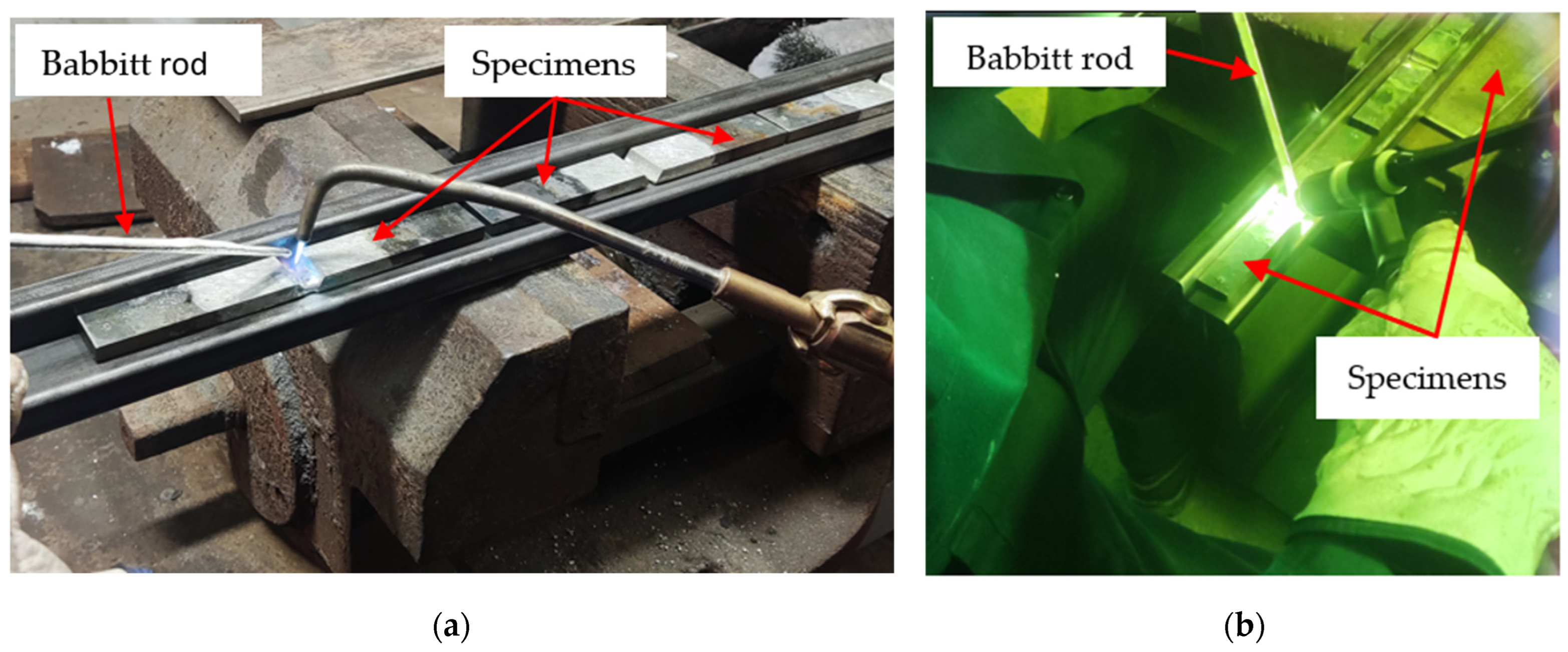

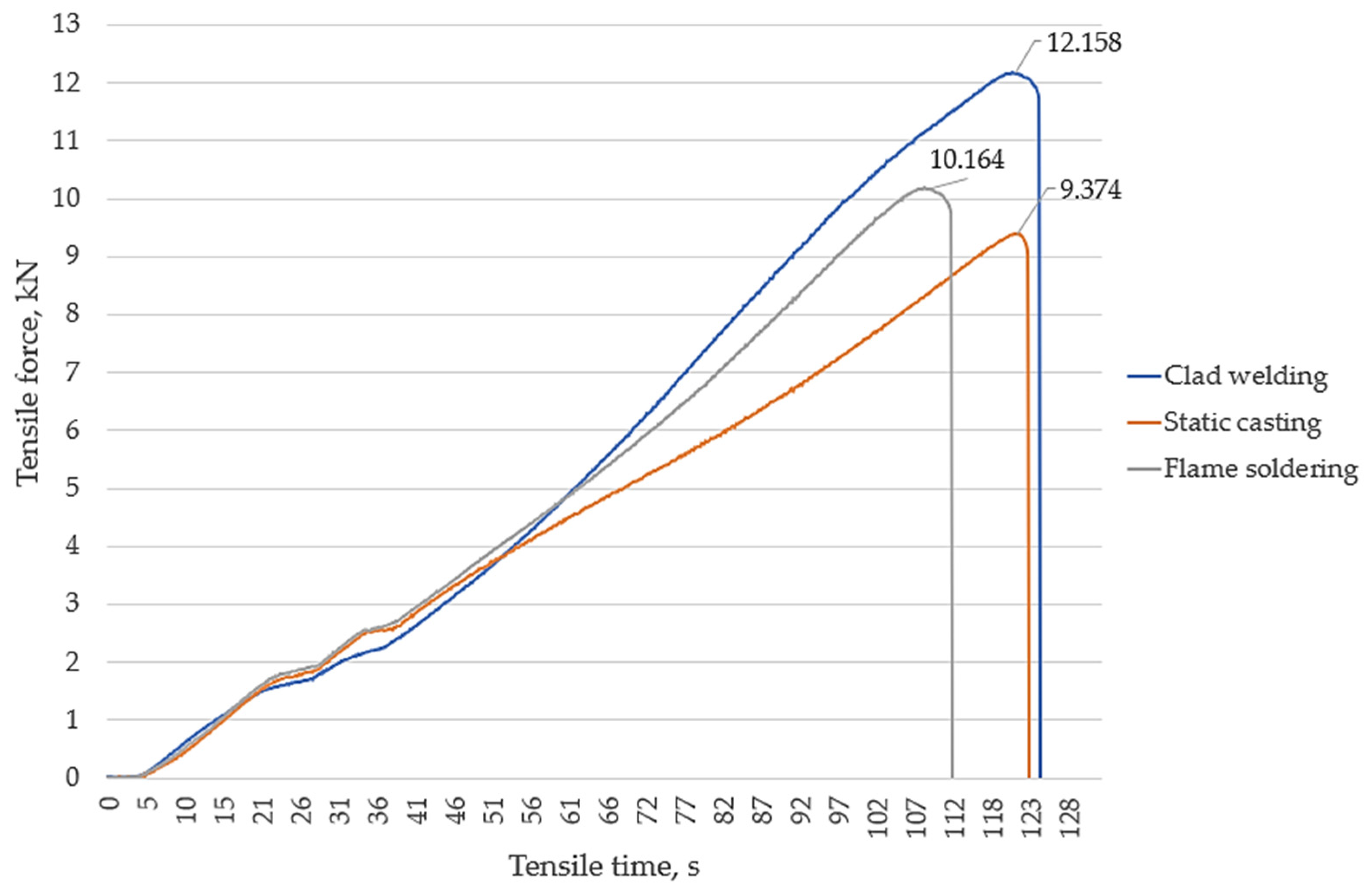
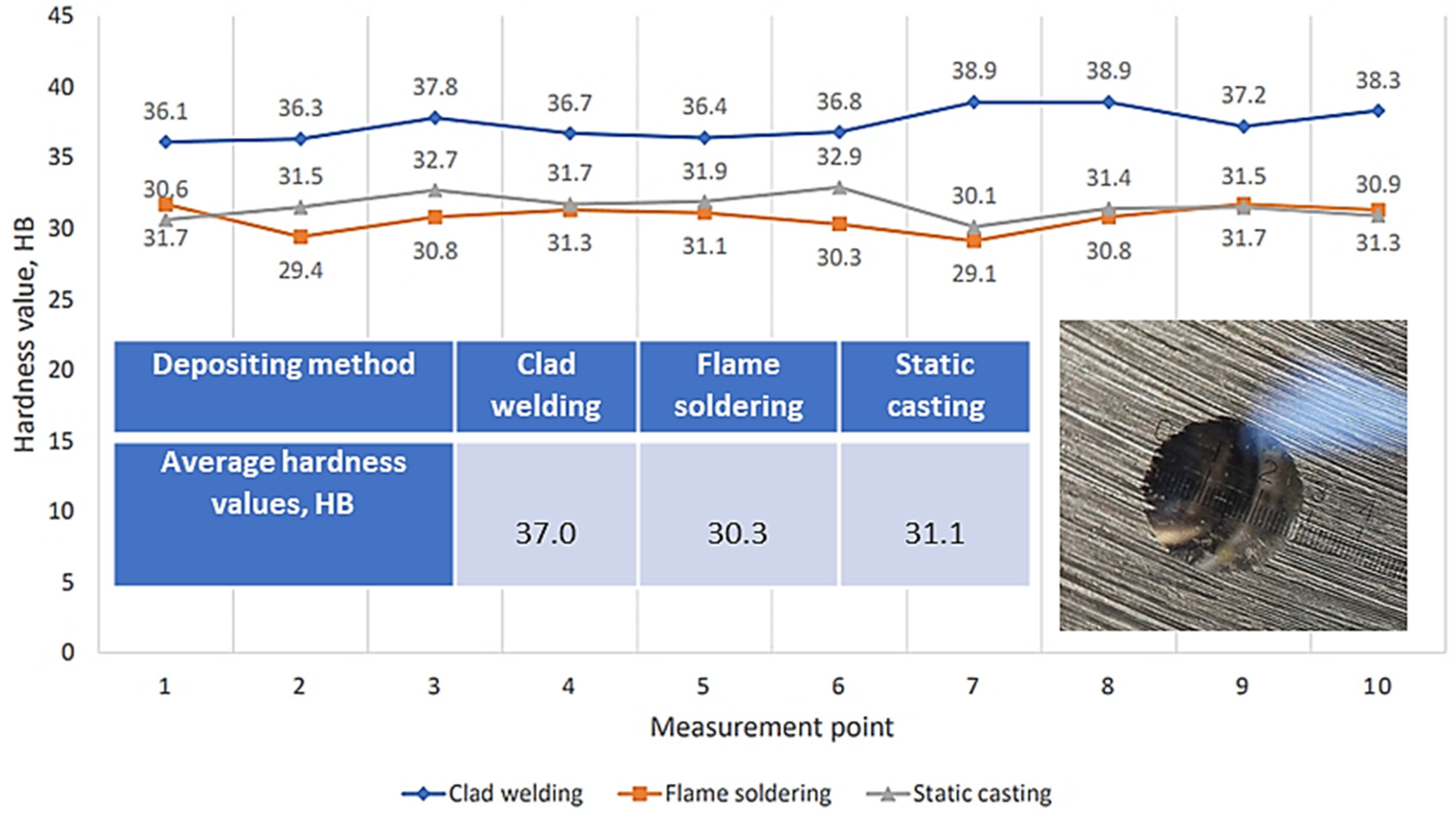

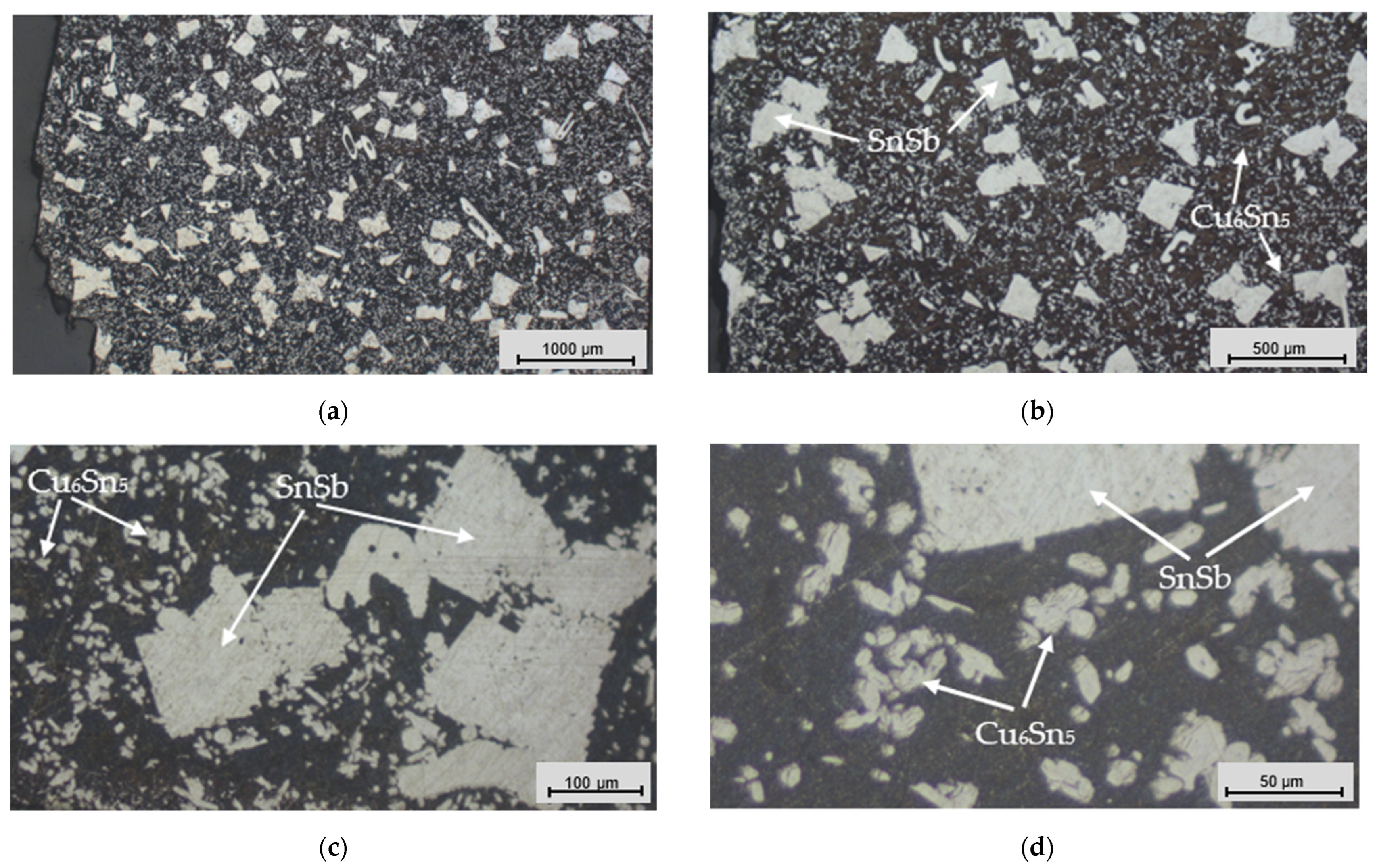
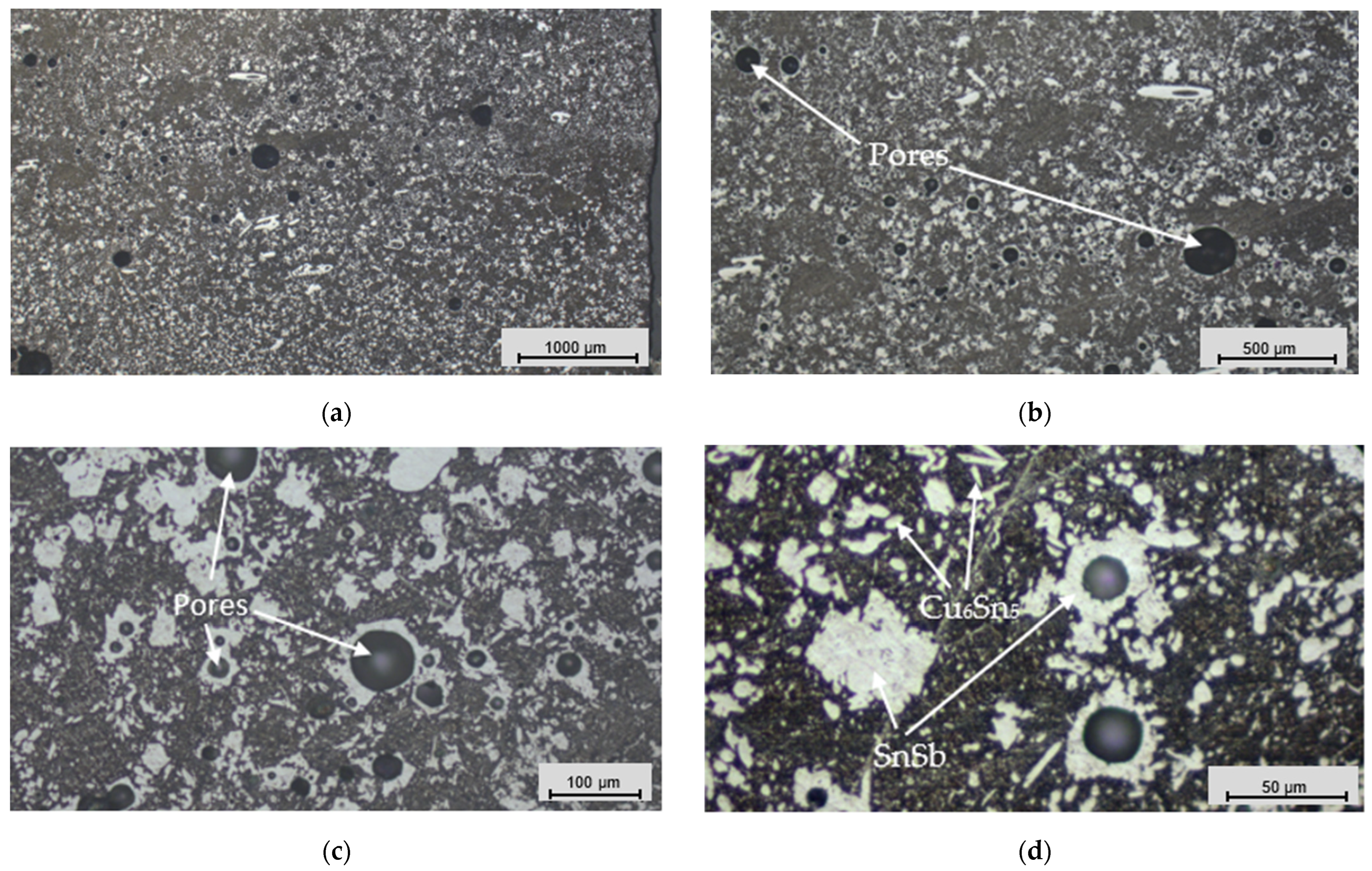
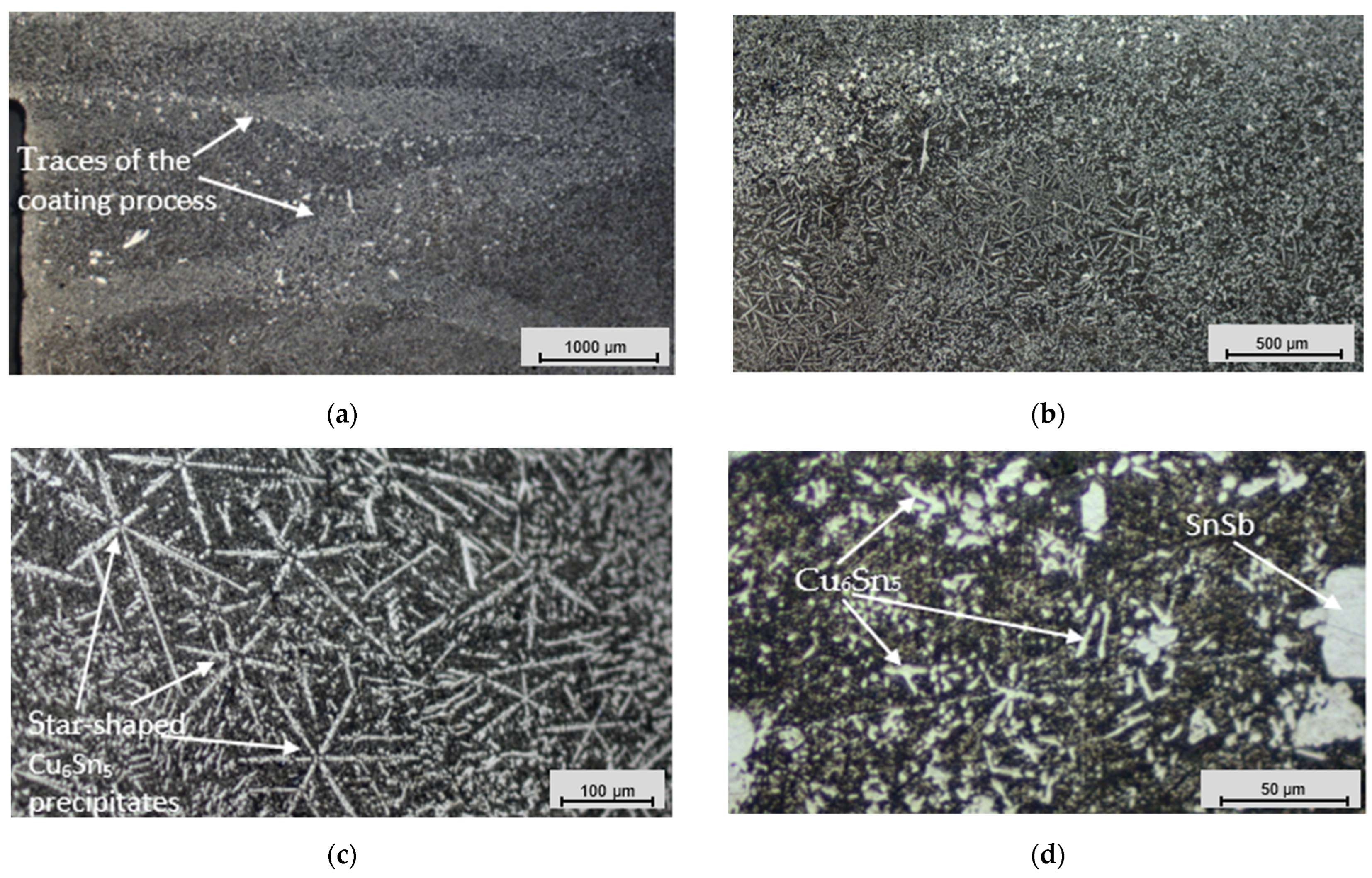
| Chemical Element | Fe | Al | Cu | As | Pb | Zn | Sb | Bi | Sn |
|---|---|---|---|---|---|---|---|---|---|
| Amount (wt.%) | 0.090 | 0.002 | 5.60 | 0.007 | 0.094 | 0.006 | 13.40 | 0.001 | Bal. |
| Deposition Method | Percentage of Chemical Elements in the Composition (wt.%) | |||||||
|---|---|---|---|---|---|---|---|---|
| Static casting | Sn | Sb | As | Bi | Pb | Cu | Fe | Ni |
| Balance | 12.40 | 0.007 | 0.001 | 0.034 | 3.73 | 0.090 | 0.001 | |
| Al | Zn | Cd | Ag | Co | In | |||
| 0.002 | 0.006 | 0.001 | 0.001 | 0.003 | 0.004 | |||
| Flame soldering | Sn | Sb | As | Bi | Pb | Cu | Fe | Ni |
| Balance | 12.70 | 0.007 | 0.001 | 0.093 | 3.69 | 0.090 | 0.001 | |
| Al | Zn | Cd | Ag | Co | In | |||
| 0.002 | 0.006 | 0.001 | 0.001 | 0.002 | 0.006 | |||
| Clad welding | Sn | Sb | As | Bi | Pb | Cu | Fe | Ni |
| Balance | 13.10 | 0.007 | 0.001 | 0.051 | 5.57 | 0.090 | 0.001 | |
| Al | Zn | Cd | Ag | Co | In | |||
| 0.002 | 0.006 | 0.001 | 0.001 | 0.003 | 0.004 | |||
| Description of the Specimen | Max. Load Fmax (kN) | Ultimate Tensile Strength Rm (MPa) (N/mm2) | The Location of the Failure | |
|---|---|---|---|---|
| Coating Method | No. of the Specimen | |||
| Static casting (SC) | SC1 | 8.38 | 69.00 | Bonding point of the Babbitt to the base metal |
| SC2 | 5.58 | 46.00 | Bonding point of the Babbitt to the base metal | |
| SC3 | 9.37 | 78.00 | Bonding point of the Babbitt to the base metal | |
| SC4 | 5.22 | 44.00 | Bonding point of the Babbitt to the base metal | |
| SC5 | 7.04 | 58.00 | Bonding point of the Babbitt to the base metal | |
| ∆59.00 | ||||
| Flame soldering (FS) | FS1 | 6.97 | 58.00 | Bonding point of the Babbitt to the base metal |
| FS2 | 6.78 | 57.00 | Babbitt coating | |
| FS3 | 9.30 | 77.00 | Babbitt coating | |
| FS4 | 10.16 | 84.00 | Babbitt coating | |
| FS5 | 9.46 | 78.00 | Bonding point of the Babbitt to the base metal | |
| ∆71.00 | ||||
| Clad welding (CW) | CW1 | 12.16 | 102.00 | Bonding point of the Babbitt to the base metal |
| CW2 | 8.04 | 67.00 | Bonding point of the Babbitt to the base metal | |
| CW3 | 9.71 | 80.00 | Bonding point of the Babbitt to the base metal | |
| CW4 | 10.66 | 88.00 | Babbitt coating | |
| CW5 | 9.42 | 79.00 | Babbitt coating | |
| ∆83.00 | ||||
Disclaimer/Publisher’s Note: The statements, opinions and data contained in all publications are solely those of the individual author(s) and contributor(s) and not of MDPI and/or the editor(s). MDPI and/or the editor(s) disclaim responsibility for any injury to people or property resulting from any ideas, methods, instructions or products referred to in the content. |
© 2024 by the authors. Licensee MDPI, Basel, Switzerland. This article is an open access article distributed under the terms and conditions of the Creative Commons Attribution (CC BY) license (https://creativecommons.org/licenses/by/4.0/).
Share and Cite
Kačinskas, T.; Baskutis, S.; Baskutienė, J.; Kavaliauskienė, L. Investigation of the Properties of Anti-Friction Coatings Deposited with Different Casting Methods. Materials 2024, 17, 2662. https://doi.org/10.3390/ma17112662
Kačinskas T, Baskutis S, Baskutienė J, Kavaliauskienė L. Investigation of the Properties of Anti-Friction Coatings Deposited with Different Casting Methods. Materials. 2024; 17(11):2662. https://doi.org/10.3390/ma17112662
Chicago/Turabian StyleKačinskas, Tomas, Saulius Baskutis, Jolanta Baskutienė, and Lina Kavaliauskienė. 2024. "Investigation of the Properties of Anti-Friction Coatings Deposited with Different Casting Methods" Materials 17, no. 11: 2662. https://doi.org/10.3390/ma17112662
APA StyleKačinskas, T., Baskutis, S., Baskutienė, J., & Kavaliauskienė, L. (2024). Investigation of the Properties of Anti-Friction Coatings Deposited with Different Casting Methods. Materials, 17(11), 2662. https://doi.org/10.3390/ma17112662










